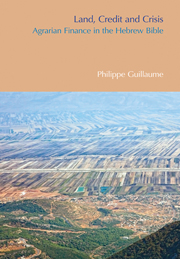9 - Financing Production and Commerce
from Part III - No Crisis in Yehud
Summary
The present shift in the dating of the Persian revitalization of Jerusalem from Darius I to Artaxerxes I represents a time extention of a good 60 years. The erection of an administrative centre at Jerusalem around 450 BCE was but the culmination of a process that began soon after Xerxes' recovery of Egypt in 484 BCE. Considering the peripheral position of Yehud, the three decades between Xerxes' realization that Egypt was a weak link and the completion of the Jerusalem birtā correspond to the time it would take for new developments on the coast to make a significant enough impact on the economy of Yehud to justify the construction of an administrative structure at Jerusalem. I use these decades as the historical ground for the ban on sowing in the seventh year, the ban on interest-bearing loans, the seventh-year Šemiṭṭah and the jubilee in an attempt to go beyond the common claim that these measures were Utopian.
Seventh-year Debt Cancellation Šemiṭṭah
The Wrigley and Schofield paradox (see §3) is based on the poor correlation between mortality among the medieval poor and famines. It implies the existence of relief systems and effective consumption-smoothing mechanisms that are invisible to the historian. I suggest that a similar paradox applies to first-millennium BCE farming in Canaan. Although the Bible mentions consumption-smoothing mechanisms, exegetes speculate that they did not work. Besides the fact that exegetes have a vested interest in downplaying the efficacy of these measures because without a crisis an unfavourable light is cast upon prophetic fulminations, the characterization of biblical financial texts as Utopian is the result of misunderstanding.
- Type
- Chapter
- Information
- Land, Credit and CrisisAgrarian Finance in the Hebrew Bible, pp. 233 - 246Publisher: Acumen PublishingPrint publication year: 2012



